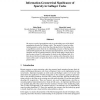Free Online Productivity Tools
i2Speak
i2Symbol
i2OCR
iTex2Img
iWeb2Print
iWeb2Shot
i2Type
iPdf2Split
iPdf2Merge
i2Bopomofo
i2Arabic
i2Style
i2Image
i2PDF
iLatex2Rtf
Sci2ools
NIPS
2001
2001
Information-Geometrical Significance of Sparsity in Gallager Codes
We report a result of perturbation analysis on decoding error of the belief propagation decoder for Gallager codes. The analysis is based on information geometry, and it shows that the principal term of decoding error at equilibrium comes from the m-embedding curvature of the log-linear submanifold spanned by the estimated pseudoposteriors, one for the full marginal, and K for partial posteriors, each of which takes a single check into account, where K is the number of checks in the Gallager code. It is then shown that the principal error term vanishes when the parity-check matrix of the code is so sparse that there are no two columns with overlap
| Added | 31 Oct 2010 |
| Updated | 31 Oct 2010 |
| Type | Conference |
| Year | 2001 |
| Where | NIPS |
| Authors | Toshiyuki Tanaka, Shiro Ikeda, Shun-ichi Amari |
Comments (0)

